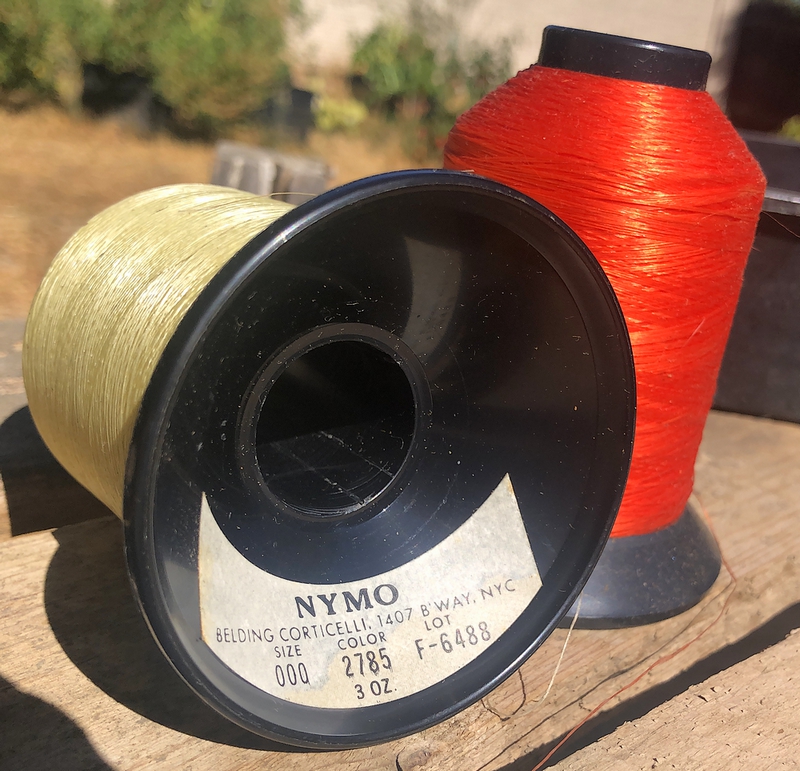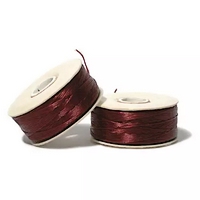
NYMO, by the Belding Cortecelli Company, was the first nylon sewing thread that relegated all the buttonhole twists, silks, and cotton threads of yesteryear to the scrap heap. As a young tier, I marveled at its strength and how it could be spun via a bobbin into both a round small thread, and unspun to generate a flat thread that added little bulk. We gleefully spun the bobbin to produce the round variant that would knife through deer hair, and attached feathers and hackle tip wings via the flat, “no bulk”, flavor. It was revolutionary to the fly tying realm and changed our perspective of threads and their capabilities forever.
… and then came the news they were taking it away …
As this predates the Internet and online shopping, a large city might have access to a fly shop, whose stock was quickly cleaned out, and the rest of us were left ransacking sewing stores, millinery outlets, and wandering around any premises that sold fabric, hoping to find a thread section.
While the thread was magical in the fly tying circles, it sucked horribly as a sewing thread. The “Use warm Iron” admonishment on every spool, meant just that … as using a hot iron would melt nylon and the garment fell apart. This didn’t sit well with the sewing community, nor the dry cleaners, so the Belding Cortescelli Company removed the thread from the mainstay outlets.
I remember spying a few spools of size “A” White at one of the International Anglers Expositions, and as I pointed a shaking finger at the treasure and fumbled for my billfold, was grilled by the proprietor as to how, ” …had I never used it before, I shouldn’t … as it was being pulled off the market.”
I was successful in laying in a small stock of Size A, in black and white, then resigned myself to the notion that on their consumption it was back to the crappy threads of yore.
Fortunately, Monocord emerged shortly after NYMO disappeared, and I, as well as my fellow fly tiers, learned that tying tiny dry flies with “000” (3/0,three-ought) was infinitely superior than the thicker, Size “A” NYMO we had squirreled away. NYMO had been available in 3/0 as well, but when the run started on its dwindling stocks, only “A” was available for hoarding.
What brought back all those distant memories was my recent discovery that NYMO has been reintroduced by Belding Cortiscelli, and is marketed as a “beading thread.” Beading thread is a heavy, coarse thread designed for constructing beaded bracelets and other bead jewelry. Most commonly used by jewelry makers in Size “D”, for strength, the venerable NYMO is available in few fly tying sizes as well. The smallest I’ve found is “00” (2/0, or two-ought), which isn’t likely to unseat our existing threads like Danville’s 6/0 Flymaster, 8/0 Ultra, or UNI threads, but it could prove economical for tying larger flies like steelhead, bass, and saltwater flies.
In addition, the packaging of NYMO offers both “Cones” and spools designed for sewing machines, which fit the Matarelli Midge bobbin, something our current spools do not. As thread hasn’t been available in cones to us fly tiers since the late seventies, most tiers will not find the 3 ounce and 6 ounce (or 1lb) cones attractive. In the olden days, we would decant thread off a cone by placing a spool on a power drill and loading the thread from the cone onto the empty spool akin to adding backing to a fly reel. The six ounce cones cost somewhere between $22 and $55, depending on the source, and hold about 5000 yards of thread, nearly 50 – 100yd spools. The sewing machine spools are 145 yard spools (size 2/0) and range anywhere from about a dollar, to about $4.50 per spool. It pays to refine your search to get the best pricing, and you need to frequent beading and craft stores, not fly shops. Etsy and Ebay are your friends as well.
I was able to secure quite a few individual spools for about $1 per spool. I grabbed some black, white, and blue, in the 2/0 size, as I am making a lot of salt water flies for a donation project I am working on. I routinely find these on Ebay, sold in various colors and sizes, in odd lots sold by private individuals. It appears they use thread colors for a specific project, then move onto other jewelry using other thread colors. Remnants of their past project are then sold on Ebay or Etsy at a reduced price.
Given the wide variety in pricing for the thread, I would only purchase it on sale or on the cone. If you opt for the cone, save empty plastic bobbins first to give you something to offload onto, as the cone is unusable until you transfer the thread to spools useful for your traditional (or midge) bobbin. Store all threads out of direct sunlight, as that is nylon’s nemisis. I am using size “A” NYMO that is nearly fifty years old, and due to dark storage, it has retained its strength without decay.
Many new colors are available that were not present in the past, so we can thank the jewelry and craft folks for insisting on all the muaves, puces, and goldenrods, we enjoy today. As a cautionary note, do not assume you are getting the 2/0 size unless it is plainly marked (or advertised) as such. The most common sizes used for beading appears to be “D”, which is considerably larger than anything we use today.
It’s nice to have a few alternatives to the fly tying brands, given how inexpensive threads are to manufacture.


